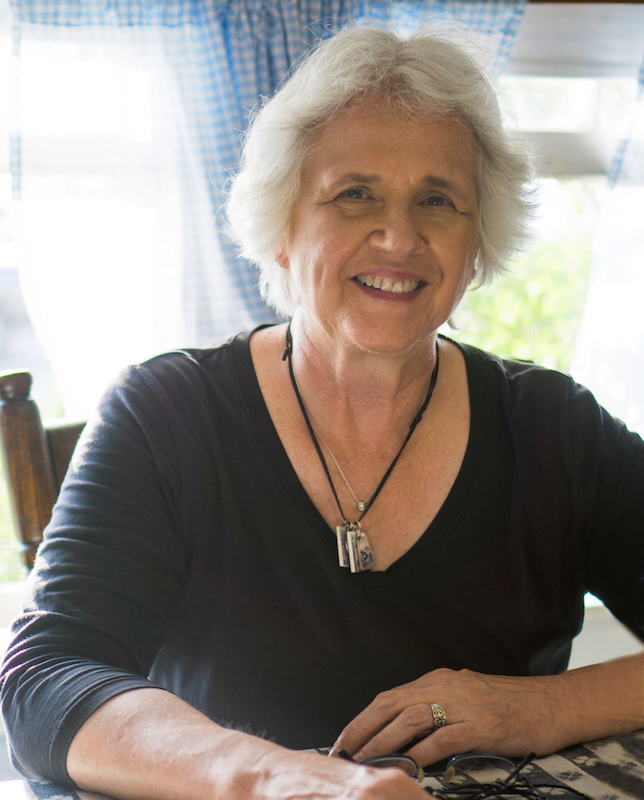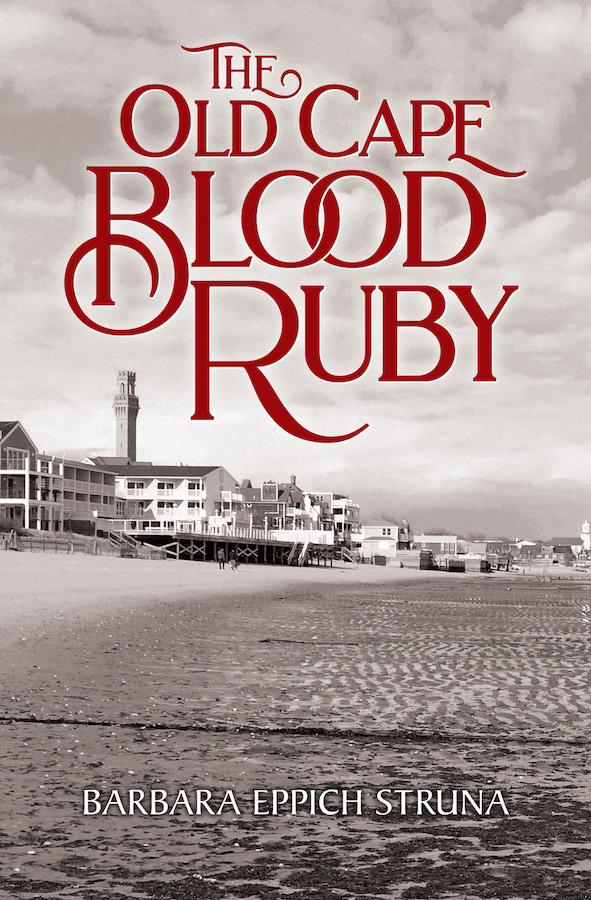A Visit With Barbara Eppich Struna
NG: Welcome to a chat with award-winning historical mystery series author, Barbara Eppich Struna. I met Barbara during my recent visit to Brewster, MA on Cape Cod. Barbara has a fascinating background: Not only does she write fiction; she also wrote a memoir of her sister’s life and is involved with her husband’s art gallery. Welcome, Barbara!
BES: Thank you Nancy. It was a pleasure to meet and speak with you on that lovely summer day in Brewster.
NG: One of the historical Cape Cod figures appearing throughout your mystery series is Maria Hallett, an actual 18th-century woman who was labeled a witch, whipped, and sent to jail after her pirate lover left her alone and pregnant. Tell us more about why you wanted to bring Maria’s story to life.
BES: The legend of Sam Bellamy and Maria Hallett impressed me during my 1988 visit to the Pirate Museum on MacMillian Wharf in Provincetown. On the ride home from our museum tour, I couldn’t get Maria’s sad story out of my head.
I felt she was falsely labeled a witch based on her quirky actions and the fact she fell in love with a pirate. There was no dancing or frivolous singing allowed in Puritan life, and maybe Maria couldn’t give up the happiness of such simple acts. I researched but couldn’t find any actual records for her, only in myth and legend, whereas, Sam’s life on his ship, The Whydah, was well-documented. With a few factual details about Maria, my imagination took off. I combined her story with that of a modern-day woman who finds clues to the past in a root cellar in Brewster.
My dedication for The Old Cape House reads: “… I dedicate this book to all women of the past who sought freedom to be themselves and dance under the moon.” I love to think I’m filling the missing holes in history.
NG: The latest in your series is called The Old Cape Blood Ruby. A compelling title. Tell us a bit about the premise of the story.
BES: In 1898, the Portland Gale tore across Provincetown on Cape Cod’s coast. Walter Ellis, a descendant of legendary Maria Hallett, loses his ship and fishing livelihood. Forced to leave his family behind, he seeks gold in Alaska but never returns.
Present day Nancy Caldwell travels to Alaska to visit family. She discovers an old letter destined for Provincetown but never sent. Back home on Cape Cod, a 1780s house, a hidden ‘pigeon’s blood’ ruby ring, and a past nemesis complicate Nancy’s search for what happened to the missing fisherman.
Using dueling timelines between centuries, the historical fiction, The Old Cape Blood Ruby, follows Nancy as she untangles the lost message’s clues, in a quest filled with love, heartbreak, and treasure.
NG: Your mysteries are steeped in setting: Cape Cod, MA, Juneau, Alaska, and Hollywood, CA. An Alaskan educator gave high marks to The Old Cape Blood Ruby for your portrayal of Alaska’s Tlingit Native American culture. Tell us a bit about how you went about your research into that culture.
BES: Every state in the United States has a unique Native American story. The distinctive tribal communities deserve to be highlighted within each state’s culture and history. Often that does not happen.
When my husband and I visited our son and his family in Juneau, Alaska, I was drawn to its history and Juneau’s native people, the Tlingit’s. My grandchildren attended Auke Bay Elementary School, and the Tlingit heritage was studied throughout the school. In fact, the girls would come home with Tlingit sayings or words. I grew more interested when my youngest granddaughter said thank you to me in Tlingit, Gunalchéesh!
Travelling on the long plane rides back and forth to Cape Cod, I began to plot, The Old Cape Blood Ruby. With each successive trip, I gathered contacts associated with the Tlingit culture from the other parents and educators.
NG: I enjoyed visiting one of the two family-run art galleries that showcase your husband Timothy’s paintings and prints. Does being married to a visual artist impact the way you write?
Visit the Struna Gallery website here: https://www.strunagalleries.com/
BES: Since I was eleven years old, I’ve kept a diary. I still do. I like to tell stories, always making up fantasies for my kids at bedtime. I always had a strong imagination. And yes, living with an artist and leading an artful and peaceful life enabled me to dream and wonder and question… what if?
When we moved to the Cape, the old house we bought inspired me to write about our adventure, including dragging our three disappointed teenagers along, who didn’t want to leave their mid-west home. Upon arriving to Brewster and our 1880 house, we discovered our house had a lot of secrets and problems, but we made it our home and created two more children for a total of five beautiful, talented, and successful offspring.
NG: Was it difficult to juggle artistic careers when your kids were growing up?
BES: From the beginning of our married life, art was always present. We both decided that pursuing an art career for Tim was going to be our goal. It wasn’t easy.
Tim taught elementary art for the first eleven years of our married life to keep us fed and clothed. While other teachers would find part-time jobs during their summers off, Tim would sell his work at art festivals.
As success from the sales of his artwork increased, we finally took a giant leap towards our creative path as a family, including our three young children. In 1980, Tim resigned from teaching and we lived solely on his art income. After another eight years of hard work and sacrifice, in 1988 we relocated to Cape Cod.
Throughout our life together, we’ve always supported each other’s creative endeavors, starting with me becoming Tim’s business manager. I also became proficient in macramé and basketry—selling and exhibiting alongside Tim at art exhibits.
For a long time, I considered writing a novel, but it wasn’t until 2006 that I got serious about writing and began my research. In 2012, my first novel was published by a small press.
NG: You wrote about your sister in Family, Friends, and Faith: An Inspirational Life: Sister Barbara Eppich, O.S.U. She belonged to the Ursuline order of Catholic nuns. She sounds like a remarkable woman and reminds me of a wonderful friend I lost a few years back, Sister Judith Kenhart. The book quotes Sister Barbara as saying, “To me, life is like a dance.” What are some important lessons your sister taught you?
BES: Being the youngest of five children, and Sister Barbara the oldest, we had different upbringings. Many a day Sister Barbara would comment, “Mom and Dad did this and that.” I would answer, “I don’t remember that!” But we shared the core lessons taught by our parents. Be respectful, treat all as equal, do something kind every day, and believe there is a power or someone watching over you.
After the death of my parents, it was Sister Barbara who offered the lessons. She stressed the importance of Family, Friends, and Faith, as in the memoir I co-wrote. Here’s an excerpt from the memoir’s last chapter. I sincerely hope and pray that those of you who read Sister Barbara’s memoir will take away at least one idea or thought, maybe more, that will give you hope and faith that things will work for the best, and that God loves you.
NG: You recently wrote about three Cape Cod libraries for the New England chapter of Sisters in Crime. One librarian you interviewed spoke about how libraries had adapted to COVID-19 restrictions. What did you learn about today’s local library and the librarians who staff them?
BES: Researching the libraries of New England, I’ve discovered that due to Covid restrictions, our libraries have totally embraced the digital age with more e-books and Zoom presentations than ever before. The accessible knowledge bank that libraries offer has become a digital gift to everyone. Of course, I still love to visit and explore all the ins and outs of a physical library, even if it’s with a mask. It doesn’t matter… I still love it.
NG: What’s your writing routine?
BES: My day includes writing every day from about 11:00 to 5:00. If it’s not working on my novel or research, it’s time spent on social media or promotion.
Also, I write to music. No lyrics, no rhythmic tunes, not even classical. I prefer movie soundtracks and video game music. If you’re writing about being chased or being in danger, listen to the soundtracks of Inception, Batman Begins, Oblivion, The Bourne Identity—they’ll put you into a suspenseful mood.
And, I continue asking, “What if? And It could happen…”




0 Comments